Managerial Accounting Techniques, MAS and Organizational Relevance
VerifiedAdded on 2021/02/20
|13
|3946
|26
Report
AI Summary
This report provides a comprehensive overview of managerial accounting techniques, focusing on their application and relevance in contemporary organizations. It begins with an introduction to management accounting, highlighting its role in financial information analysis, cost minimization, and profit maximization within organizations like Macquarie Group Limited. The report then delves into specific techniques, including Total Quality Management (TQM), Activity-Based Costing (ABC), and Just-In-Time (JIT), detailing their methodologies and benefits. The report further examines the application of Management Accounting Systems (MAS) in modern organizations, using case studies and comparative analysis to illustrate the practical use of different techniques. It also compares and contrasts the application of MAS techniques between Company A and Macquarie Group. The conclusion emphasizes the importance of MAS in competitive and uncertain business environments, stressing planning, decision-making, and cost management. The report highlights the significance of adopting modern approaches in MAS to enhance organizational performance and provides specific outcomes and learning lessons. The report includes relevant references to support its findings.
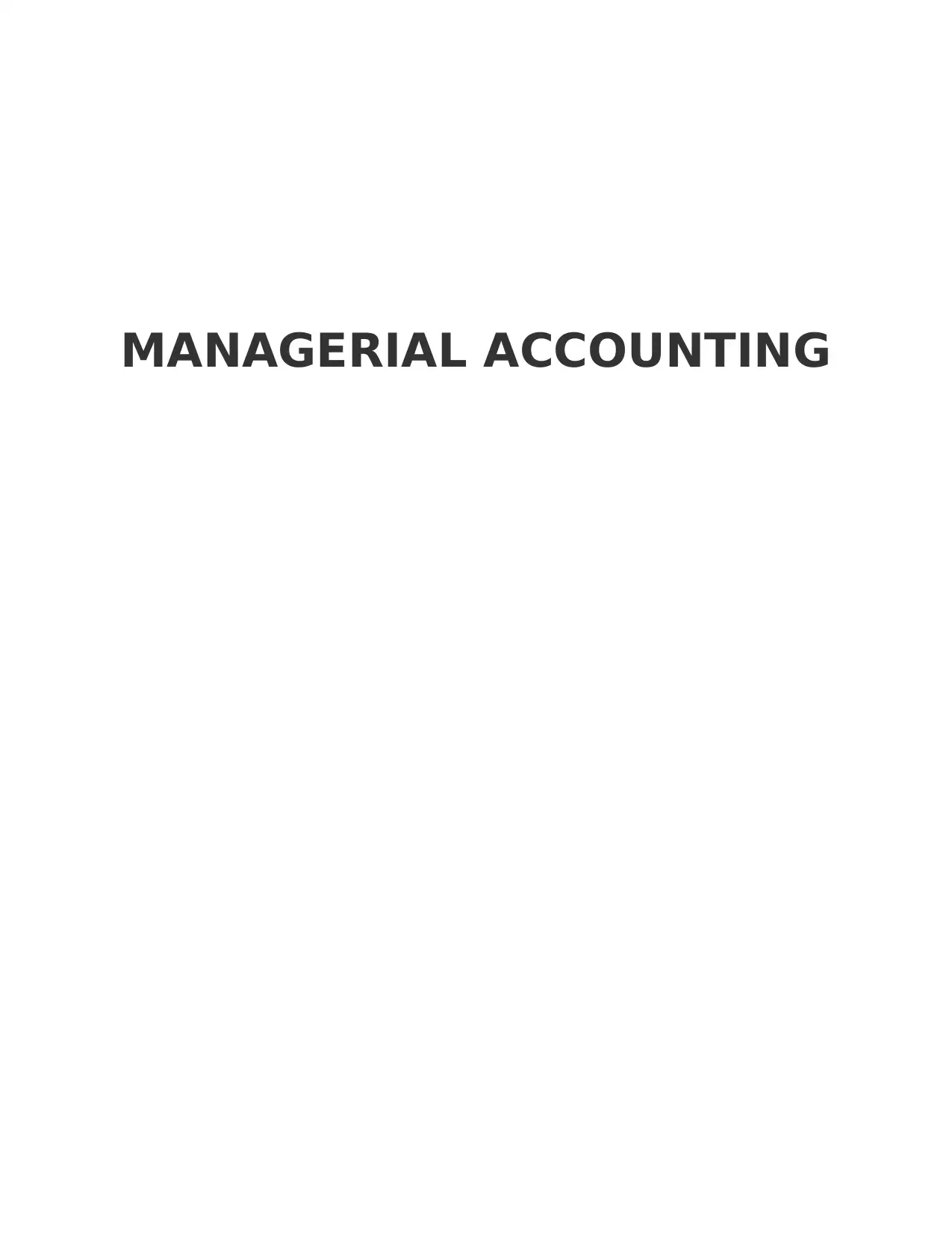
MANAGERIAL ACCOUNTING
Paraphrase This Document
Need a fresh take? Get an instant paraphrase of this document with our AI Paraphraser
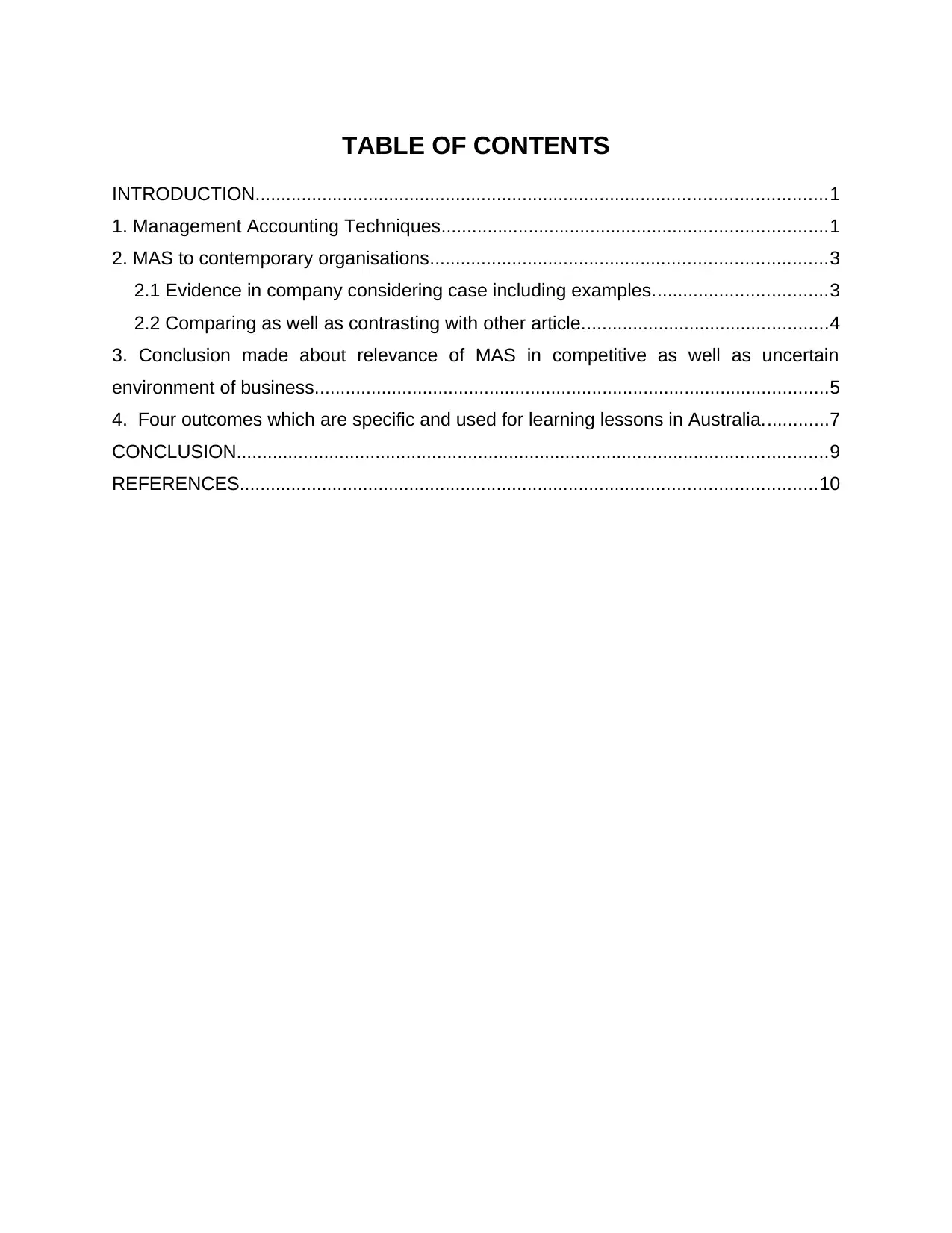
TABLE OF CONTENTS
INTRODUCTION...............................................................................................................1
1. Management Accounting Techniques...........................................................................1
2. MAS to contemporary organisations.............................................................................3
2.1 Evidence in company considering case including examples..................................3
2.2 Comparing as well as contrasting with other article................................................4
3. Conclusion made about relevance of MAS in competitive as well as uncertain
environment of business....................................................................................................5
4. Four outcomes which are specific and used for learning lessons in Australia.............7
CONCLUSION...................................................................................................................9
REFERENCES................................................................................................................10
INTRODUCTION...............................................................................................................1
1. Management Accounting Techniques...........................................................................1
2. MAS to contemporary organisations.............................................................................3
2.1 Evidence in company considering case including examples..................................3
2.2 Comparing as well as contrasting with other article................................................4
3. Conclusion made about relevance of MAS in competitive as well as uncertain
environment of business....................................................................................................5
4. Four outcomes which are specific and used for learning lessons in Australia.............7
CONCLUSION...................................................................................................................9
REFERENCES................................................................................................................10
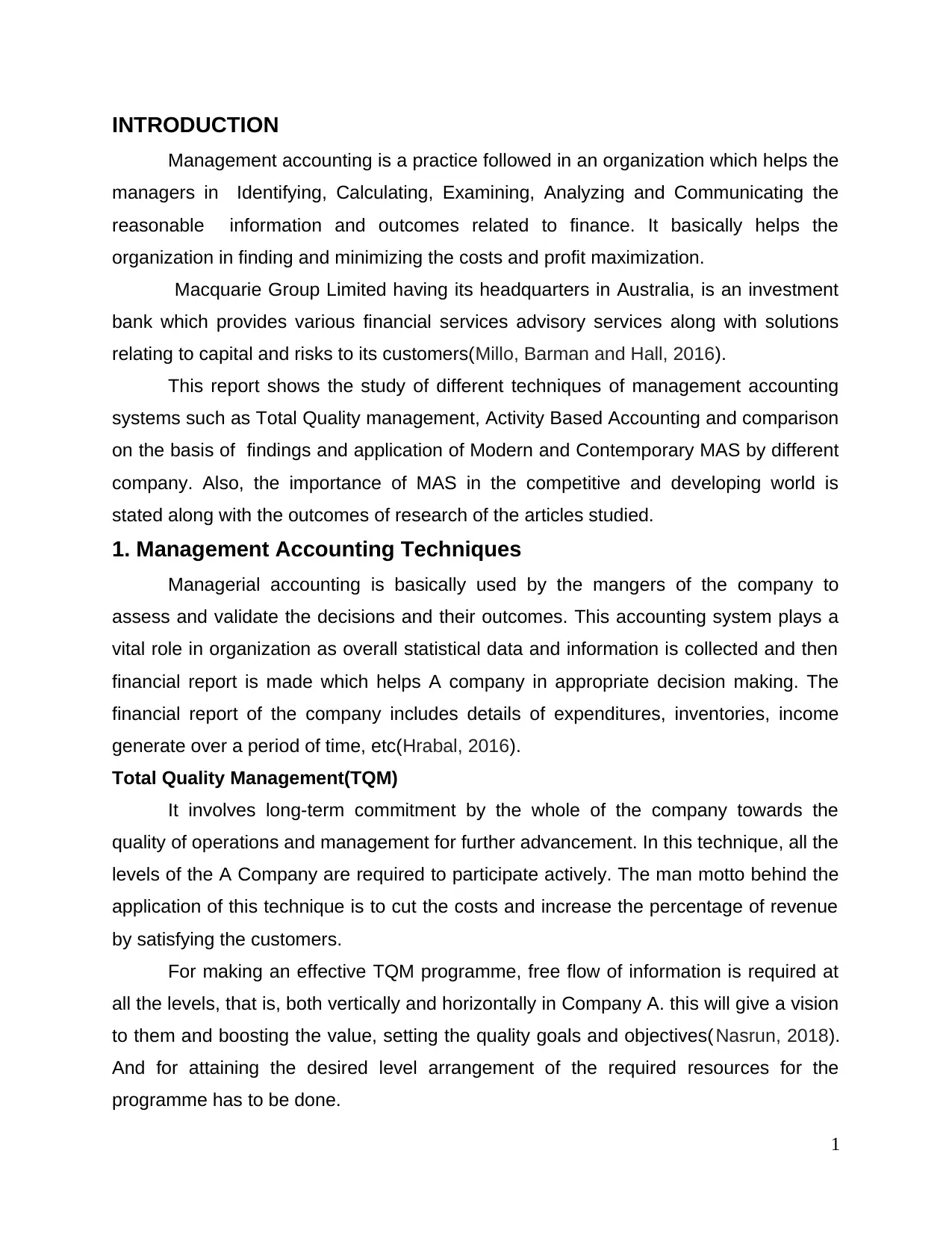
INTRODUCTION
Management accounting is a practice followed in an organization which helps the
managers in Identifying, Calculating, Examining, Analyzing and Communicating the
reasonable information and outcomes related to finance. It basically helps the
organization in finding and minimizing the costs and profit maximization.
Macquarie Group Limited having its headquarters in Australia, is an investment
bank which provides various financial services advisory services along with solutions
relating to capital and risks to its customers(Millo, Barman and Hall, 2016).
This report shows the study of different techniques of management accounting
systems such as Total Quality management, Activity Based Accounting and comparison
on the basis of findings and application of Modern and Contemporary MAS by different
company. Also, the importance of MAS in the competitive and developing world is
stated along with the outcomes of research of the articles studied.
1. Management Accounting Techniques
Managerial accounting is basically used by the mangers of the company to
assess and validate the decisions and their outcomes. This accounting system plays a
vital role in organization as overall statistical data and information is collected and then
financial report is made which helps A company in appropriate decision making. The
financial report of the company includes details of expenditures, inventories, income
generate over a period of time, etc(Hrabal, 2016).
Total Quality Management(TQM)
It involves long-term commitment by the whole of the company towards the
quality of operations and management for further advancement. In this technique, all the
levels of the A Company are required to participate actively. The man motto behind the
application of this technique is to cut the costs and increase the percentage of revenue
by satisfying the customers.
For making an effective TQM programme, free flow of information is required at
all the levels, that is, both vertically and horizontally in Company A. this will give a vision
to them and boosting the value, setting the quality goals and objectives( Nasrun, 2018).
And for attaining the desired level arrangement of the required resources for the
programme has to be done.
1
Management accounting is a practice followed in an organization which helps the
managers in Identifying, Calculating, Examining, Analyzing and Communicating the
reasonable information and outcomes related to finance. It basically helps the
organization in finding and minimizing the costs and profit maximization.
Macquarie Group Limited having its headquarters in Australia, is an investment
bank which provides various financial services advisory services along with solutions
relating to capital and risks to its customers(Millo, Barman and Hall, 2016).
This report shows the study of different techniques of management accounting
systems such as Total Quality management, Activity Based Accounting and comparison
on the basis of findings and application of Modern and Contemporary MAS by different
company. Also, the importance of MAS in the competitive and developing world is
stated along with the outcomes of research of the articles studied.
1. Management Accounting Techniques
Managerial accounting is basically used by the mangers of the company to
assess and validate the decisions and their outcomes. This accounting system plays a
vital role in organization as overall statistical data and information is collected and then
financial report is made which helps A company in appropriate decision making. The
financial report of the company includes details of expenditures, inventories, income
generate over a period of time, etc(Hrabal, 2016).
Total Quality Management(TQM)
It involves long-term commitment by the whole of the company towards the
quality of operations and management for further advancement. In this technique, all the
levels of the A Company are required to participate actively. The man motto behind the
application of this technique is to cut the costs and increase the percentage of revenue
by satisfying the customers.
For making an effective TQM programme, free flow of information is required at
all the levels, that is, both vertically and horizontally in Company A. this will give a vision
to them and boosting the value, setting the quality goals and objectives( Nasrun, 2018).
And for attaining the desired level arrangement of the required resources for the
programme has to be done.
1
⊘ This is a preview!⊘
Do you want full access?
Subscribe today to unlock all pages.

Trusted by 1+ million students worldwide
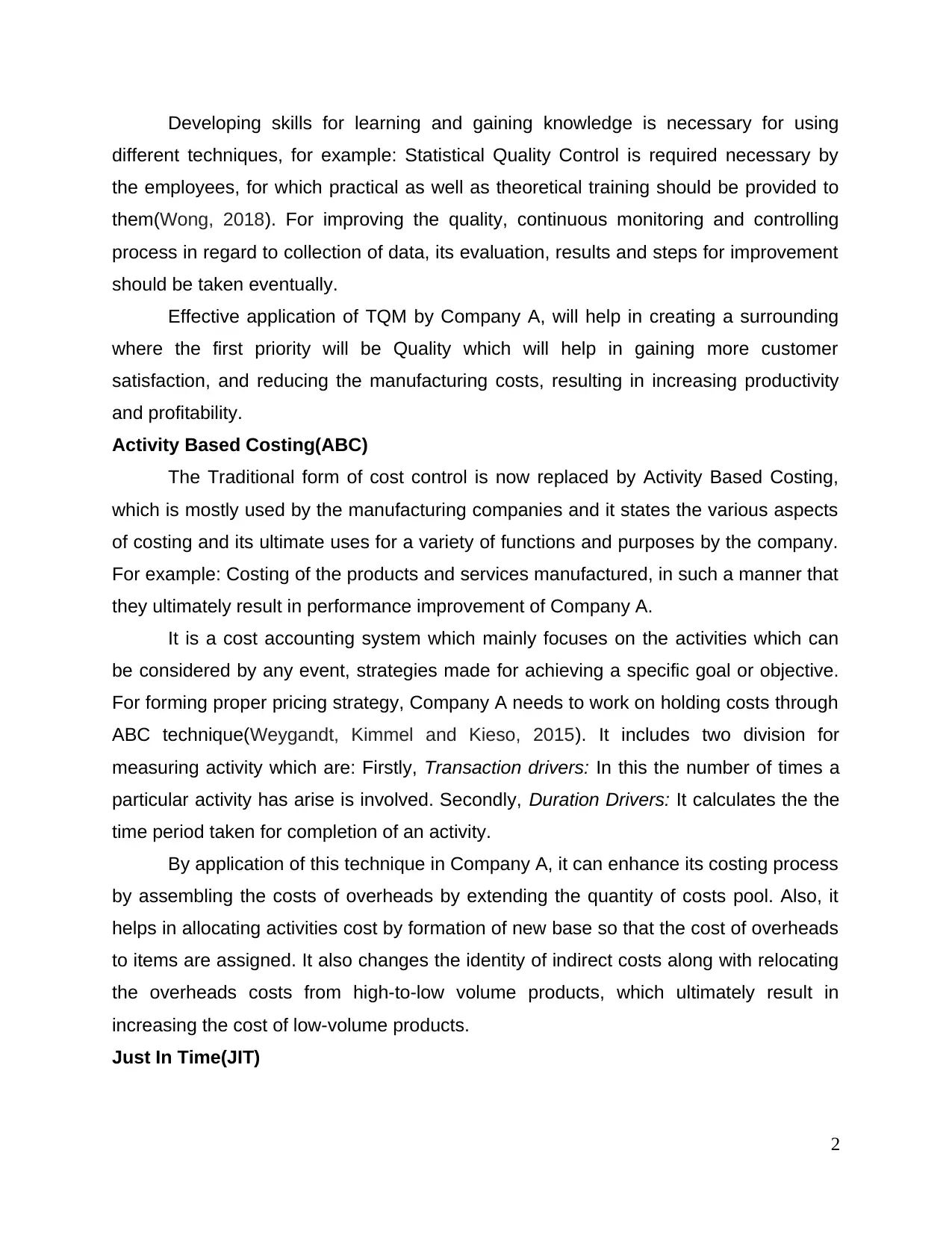
Developing skills for learning and gaining knowledge is necessary for using
different techniques, for example: Statistical Quality Control is required necessary by
the employees, for which practical as well as theoretical training should be provided to
them(Wong, 2018). For improving the quality, continuous monitoring and controlling
process in regard to collection of data, its evaluation, results and steps for improvement
should be taken eventually.
Effective application of TQM by Company A, will help in creating a surrounding
where the first priority will be Quality which will help in gaining more customer
satisfaction, and reducing the manufacturing costs, resulting in increasing productivity
and profitability.
Activity Based Costing(ABC)
The Traditional form of cost control is now replaced by Activity Based Costing,
which is mostly used by the manufacturing companies and it states the various aspects
of costing and its ultimate uses for a variety of functions and purposes by the company.
For example: Costing of the products and services manufactured, in such a manner that
they ultimately result in performance improvement of Company A.
It is a cost accounting system which mainly focuses on the activities which can
be considered by any event, strategies made for achieving a specific goal or objective.
For forming proper pricing strategy, Company A needs to work on holding costs through
ABC technique(Weygandt, Kimmel and Kieso, 2015). It includes two division for
measuring activity which are: Firstly, Transaction drivers: In this the number of times a
particular activity has arise is involved. Secondly, Duration Drivers: It calculates the the
time period taken for completion of an activity.
By application of this technique in Company A, it can enhance its costing process
by assembling the costs of overheads by extending the quantity of costs pool. Also, it
helps in allocating activities cost by formation of new base so that the cost of overheads
to items are assigned. It also changes the identity of indirect costs along with relocating
the overheads costs from high-to-low volume products, which ultimately result in
increasing the cost of low-volume products.
Just In Time(JIT)
2
different techniques, for example: Statistical Quality Control is required necessary by
the employees, for which practical as well as theoretical training should be provided to
them(Wong, 2018). For improving the quality, continuous monitoring and controlling
process in regard to collection of data, its evaluation, results and steps for improvement
should be taken eventually.
Effective application of TQM by Company A, will help in creating a surrounding
where the first priority will be Quality which will help in gaining more customer
satisfaction, and reducing the manufacturing costs, resulting in increasing productivity
and profitability.
Activity Based Costing(ABC)
The Traditional form of cost control is now replaced by Activity Based Costing,
which is mostly used by the manufacturing companies and it states the various aspects
of costing and its ultimate uses for a variety of functions and purposes by the company.
For example: Costing of the products and services manufactured, in such a manner that
they ultimately result in performance improvement of Company A.
It is a cost accounting system which mainly focuses on the activities which can
be considered by any event, strategies made for achieving a specific goal or objective.
For forming proper pricing strategy, Company A needs to work on holding costs through
ABC technique(Weygandt, Kimmel and Kieso, 2015). It includes two division for
measuring activity which are: Firstly, Transaction drivers: In this the number of times a
particular activity has arise is involved. Secondly, Duration Drivers: It calculates the the
time period taken for completion of an activity.
By application of this technique in Company A, it can enhance its costing process
by assembling the costs of overheads by extending the quantity of costs pool. Also, it
helps in allocating activities cost by formation of new base so that the cost of overheads
to items are assigned. It also changes the identity of indirect costs along with relocating
the overheads costs from high-to-low volume products, which ultimately result in
increasing the cost of low-volume products.
Just In Time(JIT)
2
Paraphrase This Document
Need a fresh take? Get an instant paraphrase of this document with our AI Paraphraser
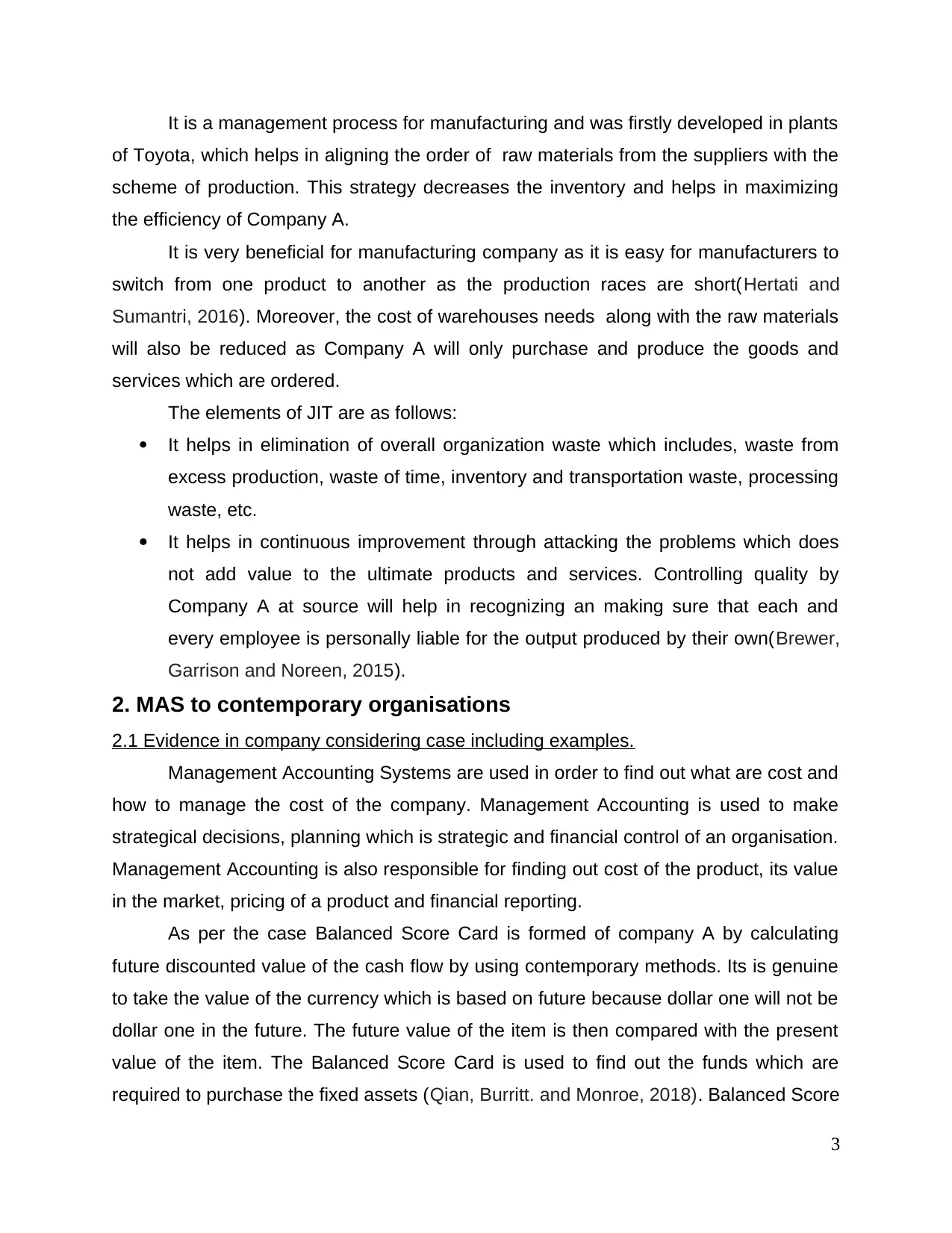
It is a management process for manufacturing and was firstly developed in plants
of Toyota, which helps in aligning the order of raw materials from the suppliers with the
scheme of production. This strategy decreases the inventory and helps in maximizing
the efficiency of Company A.
It is very beneficial for manufacturing company as it is easy for manufacturers to
switch from one product to another as the production races are short(Hertati and
Sumantri, 2016). Moreover, the cost of warehouses needs along with the raw materials
will also be reduced as Company A will only purchase and produce the goods and
services which are ordered.
The elements of JIT are as follows:
It helps in elimination of overall organization waste which includes, waste from
excess production, waste of time, inventory and transportation waste, processing
waste, etc.
It helps in continuous improvement through attacking the problems which does
not add value to the ultimate products and services. Controlling quality by
Company A at source will help in recognizing an making sure that each and
every employee is personally liable for the output produced by their own(Brewer,
Garrison and Noreen, 2015).
2. MAS to contemporary organisations
2.1 Evidence in company considering case including examples.
Management Accounting Systems are used in order to find out what are cost and
how to manage the cost of the company. Management Accounting is used to make
strategical decisions, planning which is strategic and financial control of an organisation.
Management Accounting is also responsible for finding out cost of the product, its value
in the market, pricing of a product and financial reporting.
As per the case Balanced Score Card is formed of company A by calculating
future discounted value of the cash flow by using contemporary methods. Its is genuine
to take the value of the currency which is based on future because dollar one will not be
dollar one in the future. The future value of the item is then compared with the present
value of the item. The Balanced Score Card is used to find out the funds which are
required to purchase the fixed assets (Qian, Burritt. and Monroe, 2018). Balanced Score
3
of Toyota, which helps in aligning the order of raw materials from the suppliers with the
scheme of production. This strategy decreases the inventory and helps in maximizing
the efficiency of Company A.
It is very beneficial for manufacturing company as it is easy for manufacturers to
switch from one product to another as the production races are short(Hertati and
Sumantri, 2016). Moreover, the cost of warehouses needs along with the raw materials
will also be reduced as Company A will only purchase and produce the goods and
services which are ordered.
The elements of JIT are as follows:
It helps in elimination of overall organization waste which includes, waste from
excess production, waste of time, inventory and transportation waste, processing
waste, etc.
It helps in continuous improvement through attacking the problems which does
not add value to the ultimate products and services. Controlling quality by
Company A at source will help in recognizing an making sure that each and
every employee is personally liable for the output produced by their own(Brewer,
Garrison and Noreen, 2015).
2. MAS to contemporary organisations
2.1 Evidence in company considering case including examples.
Management Accounting Systems are used in order to find out what are cost and
how to manage the cost of the company. Management Accounting is used to make
strategical decisions, planning which is strategic and financial control of an organisation.
Management Accounting is also responsible for finding out cost of the product, its value
in the market, pricing of a product and financial reporting.
As per the case Balanced Score Card is formed of company A by calculating
future discounted value of the cash flow by using contemporary methods. Its is genuine
to take the value of the currency which is based on future because dollar one will not be
dollar one in the future. The future value of the item is then compared with the present
value of the item. The Balanced Score Card is used to find out the funds which are
required to purchase the fixed assets (Qian, Burritt. and Monroe, 2018). Balanced Score
3
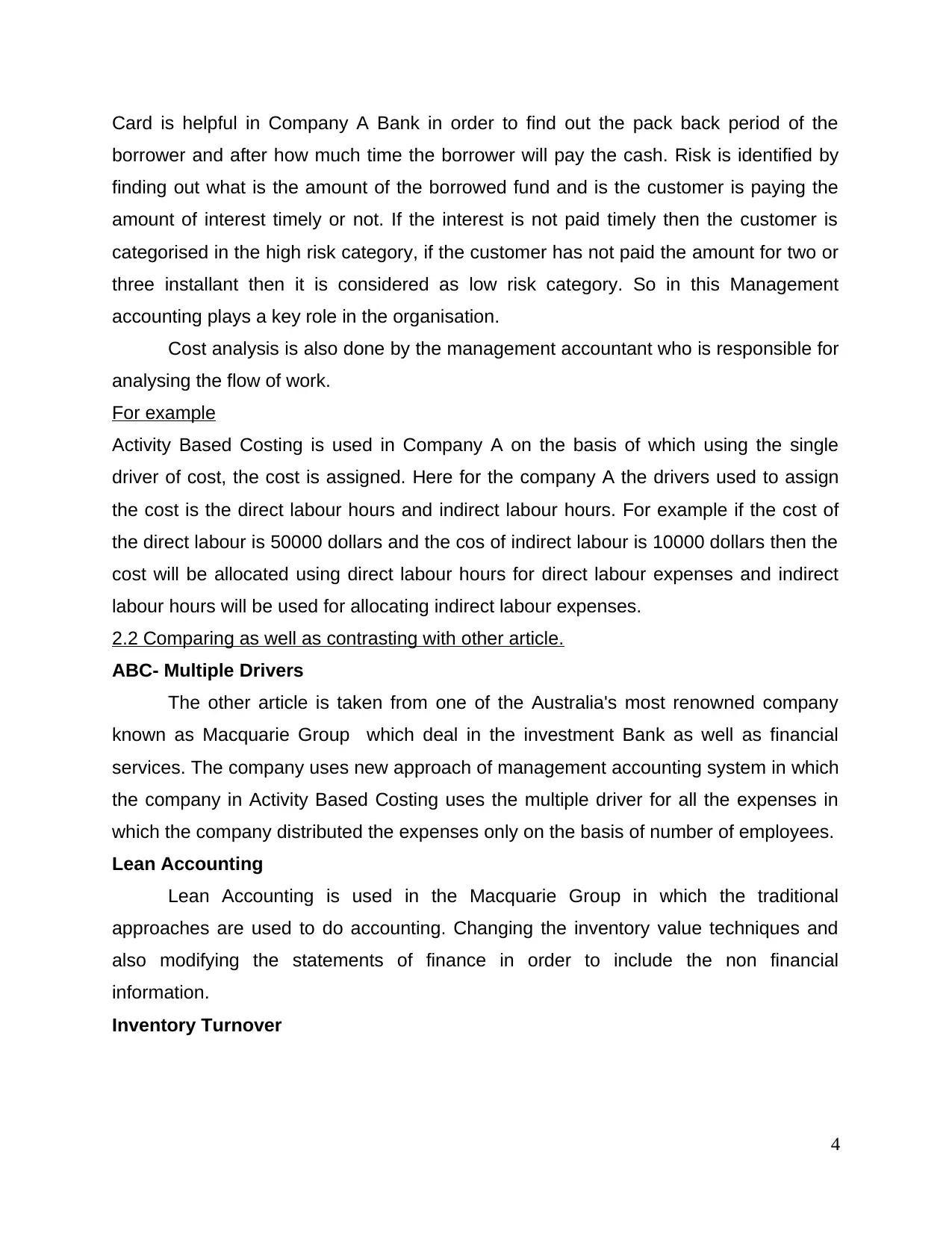
Card is helpful in Company A Bank in order to find out the pack back period of the
borrower and after how much time the borrower will pay the cash. Risk is identified by
finding out what is the amount of the borrowed fund and is the customer is paying the
amount of interest timely or not. If the interest is not paid timely then the customer is
categorised in the high risk category, if the customer has not paid the amount for two or
three installant then it is considered as low risk category. So in this Management
accounting plays a key role in the organisation.
Cost analysis is also done by the management accountant who is responsible for
analysing the flow of work.
For example
Activity Based Costing is used in Company A on the basis of which using the single
driver of cost, the cost is assigned. Here for the company A the drivers used to assign
the cost is the direct labour hours and indirect labour hours. For example if the cost of
the direct labour is 50000 dollars and the cos of indirect labour is 10000 dollars then the
cost will be allocated using direct labour hours for direct labour expenses and indirect
labour hours will be used for allocating indirect labour expenses.
2.2 Comparing as well as contrasting with other article.
ABC- Multiple Drivers
The other article is taken from one of the Australia's most renowned company
known as Macquarie Group which deal in the investment Bank as well as financial
services. The company uses new approach of management accounting system in which
the company in Activity Based Costing uses the multiple driver for all the expenses in
which the company distributed the expenses only on the basis of number of employees.
Lean Accounting
Lean Accounting is used in the Macquarie Group in which the traditional
approaches are used to do accounting. Changing the inventory value techniques and
also modifying the statements of finance in order to include the non financial
information.
Inventory Turnover
4
borrower and after how much time the borrower will pay the cash. Risk is identified by
finding out what is the amount of the borrowed fund and is the customer is paying the
amount of interest timely or not. If the interest is not paid timely then the customer is
categorised in the high risk category, if the customer has not paid the amount for two or
three installant then it is considered as low risk category. So in this Management
accounting plays a key role in the organisation.
Cost analysis is also done by the management accountant who is responsible for
analysing the flow of work.
For example
Activity Based Costing is used in Company A on the basis of which using the single
driver of cost, the cost is assigned. Here for the company A the drivers used to assign
the cost is the direct labour hours and indirect labour hours. For example if the cost of
the direct labour is 50000 dollars and the cos of indirect labour is 10000 dollars then the
cost will be allocated using direct labour hours for direct labour expenses and indirect
labour hours will be used for allocating indirect labour expenses.
2.2 Comparing as well as contrasting with other article.
ABC- Multiple Drivers
The other article is taken from one of the Australia's most renowned company
known as Macquarie Group which deal in the investment Bank as well as financial
services. The company uses new approach of management accounting system in which
the company in Activity Based Costing uses the multiple driver for all the expenses in
which the company distributed the expenses only on the basis of number of employees.
Lean Accounting
Lean Accounting is used in the Macquarie Group in which the traditional
approaches are used to do accounting. Changing the inventory value techniques and
also modifying the statements of finance in order to include the non financial
information.
Inventory Turnover
4
⊘ This is a preview!⊘
Do you want full access?
Subscribe today to unlock all pages.

Trusted by 1+ million students worldwide
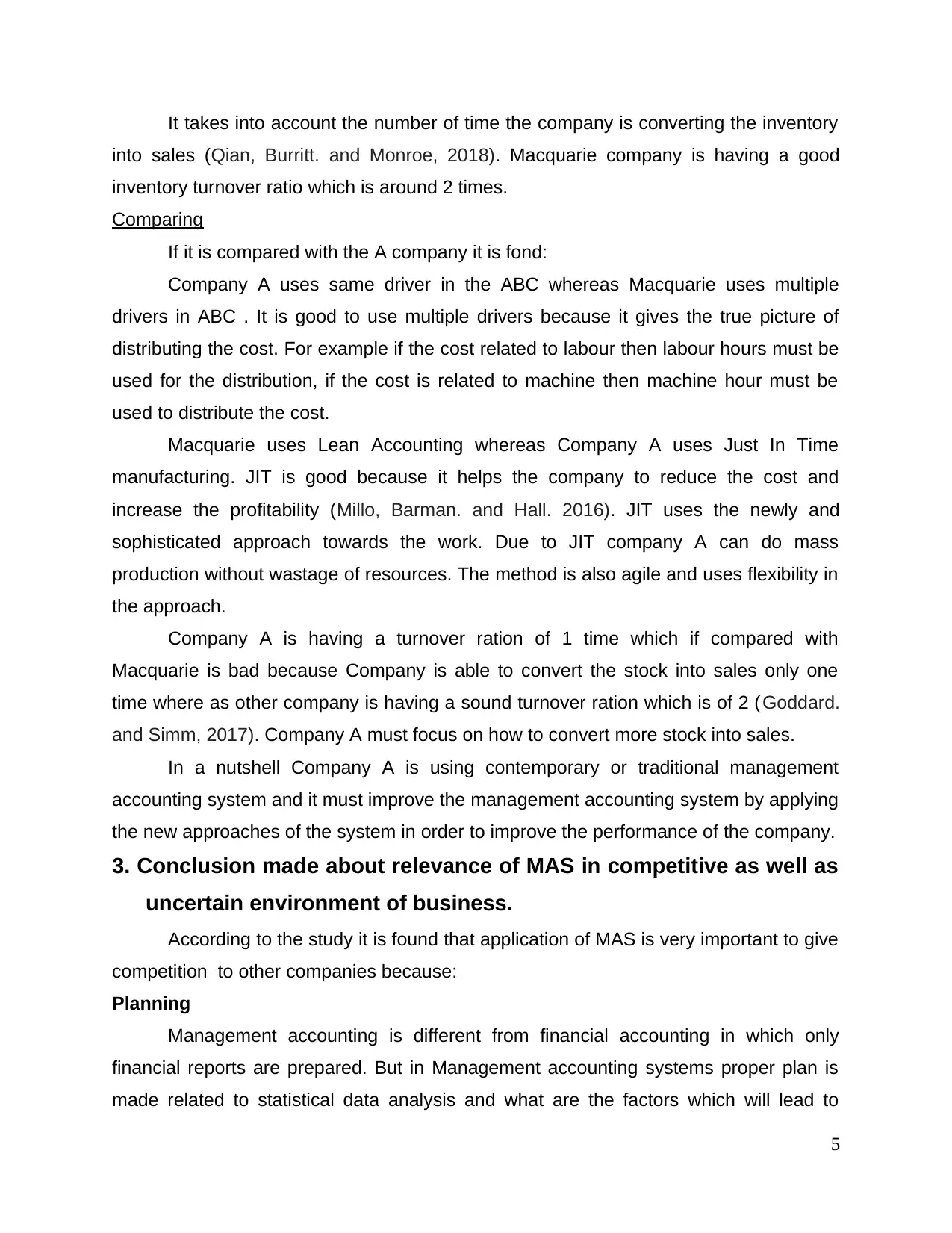
It takes into account the number of time the company is converting the inventory
into sales (Qian, Burritt. and Monroe, 2018). Macquarie company is having a good
inventory turnover ratio which is around 2 times.
Comparing
If it is compared with the A company it is fond:
Company A uses same driver in the ABC whereas Macquarie uses multiple
drivers in ABC . It is good to use multiple drivers because it gives the true picture of
distributing the cost. For example if the cost related to labour then labour hours must be
used for the distribution, if the cost is related to machine then machine hour must be
used to distribute the cost.
Macquarie uses Lean Accounting whereas Company A uses Just In Time
manufacturing. JIT is good because it helps the company to reduce the cost and
increase the profitability (Millo, Barman. and Hall. 2016). JIT uses the newly and
sophisticated approach towards the work. Due to JIT company A can do mass
production without wastage of resources. The method is also agile and uses flexibility in
the approach.
Company A is having a turnover ration of 1 time which if compared with
Macquarie is bad because Company is able to convert the stock into sales only one
time where as other company is having a sound turnover ration which is of 2 (Goddard.
and Simm, 2017). Company A must focus on how to convert more stock into sales.
In a nutshell Company A is using contemporary or traditional management
accounting system and it must improve the management accounting system by applying
the new approaches of the system in order to improve the performance of the company.
3. Conclusion made about relevance of MAS in competitive as well as
uncertain environment of business.
According to the study it is found that application of MAS is very important to give
competition to other companies because:
Planning
Management accounting is different from financial accounting in which only
financial reports are prepared. But in Management accounting systems proper plan is
made related to statistical data analysis and what are the factors which will lead to
5
into sales (Qian, Burritt. and Monroe, 2018). Macquarie company is having a good
inventory turnover ratio which is around 2 times.
Comparing
If it is compared with the A company it is fond:
Company A uses same driver in the ABC whereas Macquarie uses multiple
drivers in ABC . It is good to use multiple drivers because it gives the true picture of
distributing the cost. For example if the cost related to labour then labour hours must be
used for the distribution, if the cost is related to machine then machine hour must be
used to distribute the cost.
Macquarie uses Lean Accounting whereas Company A uses Just In Time
manufacturing. JIT is good because it helps the company to reduce the cost and
increase the profitability (Millo, Barman. and Hall. 2016). JIT uses the newly and
sophisticated approach towards the work. Due to JIT company A can do mass
production without wastage of resources. The method is also agile and uses flexibility in
the approach.
Company A is having a turnover ration of 1 time which if compared with
Macquarie is bad because Company is able to convert the stock into sales only one
time where as other company is having a sound turnover ration which is of 2 (Goddard.
and Simm, 2017). Company A must focus on how to convert more stock into sales.
In a nutshell Company A is using contemporary or traditional management
accounting system and it must improve the management accounting system by applying
the new approaches of the system in order to improve the performance of the company.
3. Conclusion made about relevance of MAS in competitive as well as
uncertain environment of business.
According to the study it is found that application of MAS is very important to give
competition to other companies because:
Planning
Management accounting is different from financial accounting in which only
financial reports are prepared. But in Management accounting systems proper plan is
made related to statistical data analysis and what are the factors which will lead to
5
Paraphrase This Document
Need a fresh take? Get an instant paraphrase of this document with our AI Paraphraser
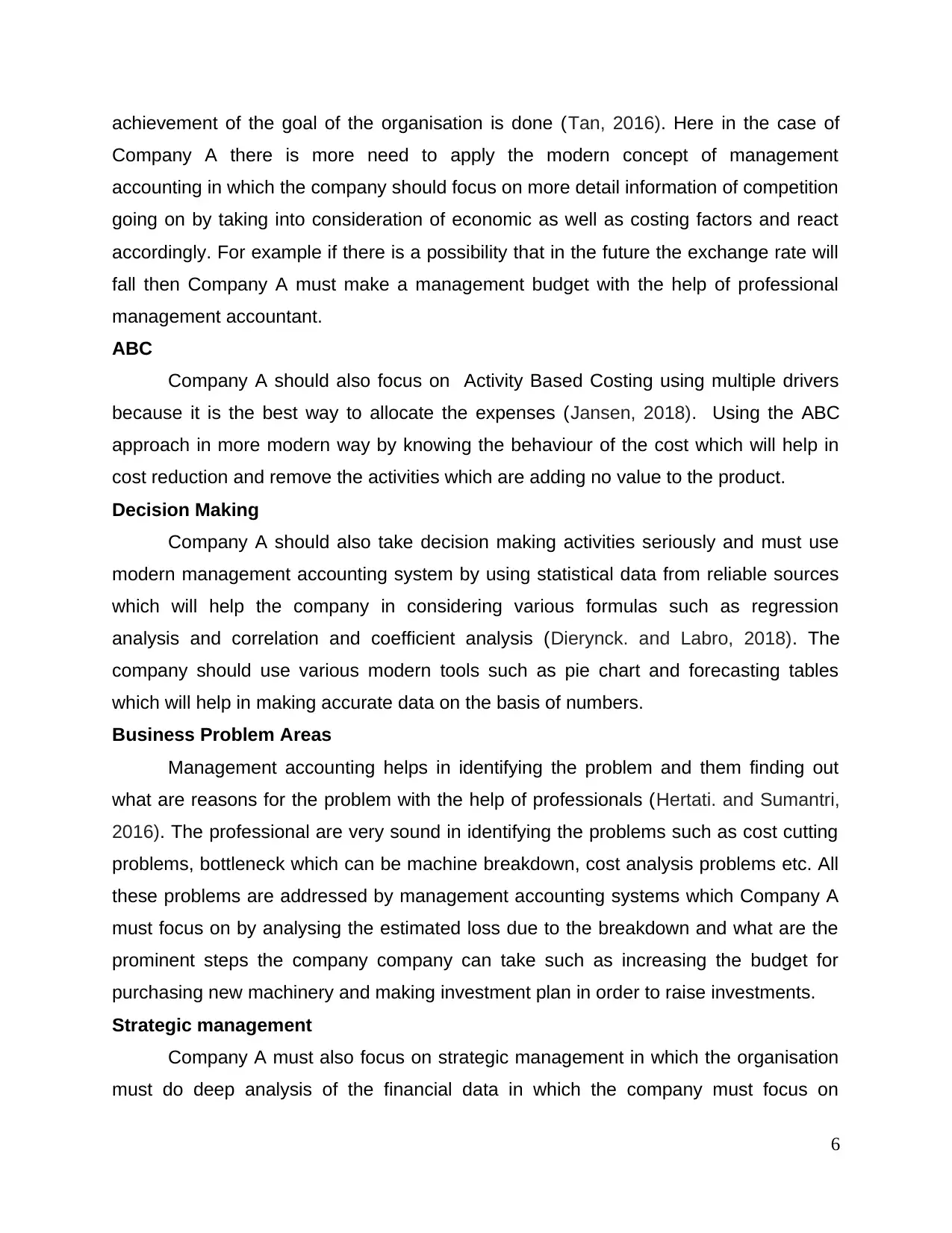
achievement of the goal of the organisation is done (Tan, 2016). Here in the case of
Company A there is more need to apply the modern concept of management
accounting in which the company should focus on more detail information of competition
going on by taking into consideration of economic as well as costing factors and react
accordingly. For example if there is a possibility that in the future the exchange rate will
fall then Company A must make a management budget with the help of professional
management accountant.
ABC
Company A should also focus on Activity Based Costing using multiple drivers
because it is the best way to allocate the expenses (Jansen, 2018). Using the ABC
approach in more modern way by knowing the behaviour of the cost which will help in
cost reduction and remove the activities which are adding no value to the product.
Decision Making
Company A should also take decision making activities seriously and must use
modern management accounting system by using statistical data from reliable sources
which will help the company in considering various formulas such as regression
analysis and correlation and coefficient analysis (Dierynck. and Labro, 2018). The
company should use various modern tools such as pie chart and forecasting tables
which will help in making accurate data on the basis of numbers.
Business Problem Areas
Management accounting helps in identifying the problem and them finding out
what are reasons for the problem with the help of professionals (Hertati. and Sumantri,
2016). The professional are very sound in identifying the problems such as cost cutting
problems, bottleneck which can be machine breakdown, cost analysis problems etc. All
these problems are addressed by management accounting systems which Company A
must focus on by analysing the estimated loss due to the breakdown and what are the
prominent steps the company company can take such as increasing the budget for
purchasing new machinery and making investment plan in order to raise investments.
Strategic management
Company A must also focus on strategic management in which the organisation
must do deep analysis of the financial data in which the company must focus on
6
Company A there is more need to apply the modern concept of management
accounting in which the company should focus on more detail information of competition
going on by taking into consideration of economic as well as costing factors and react
accordingly. For example if there is a possibility that in the future the exchange rate will
fall then Company A must make a management budget with the help of professional
management accountant.
ABC
Company A should also focus on Activity Based Costing using multiple drivers
because it is the best way to allocate the expenses (Jansen, 2018). Using the ABC
approach in more modern way by knowing the behaviour of the cost which will help in
cost reduction and remove the activities which are adding no value to the product.
Decision Making
Company A should also take decision making activities seriously and must use
modern management accounting system by using statistical data from reliable sources
which will help the company in considering various formulas such as regression
analysis and correlation and coefficient analysis (Dierynck. and Labro, 2018). The
company should use various modern tools such as pie chart and forecasting tables
which will help in making accurate data on the basis of numbers.
Business Problem Areas
Management accounting helps in identifying the problem and them finding out
what are reasons for the problem with the help of professionals (Hertati. and Sumantri,
2016). The professional are very sound in identifying the problems such as cost cutting
problems, bottleneck which can be machine breakdown, cost analysis problems etc. All
these problems are addressed by management accounting systems which Company A
must focus on by analysing the estimated loss due to the breakdown and what are the
prominent steps the company company can take such as increasing the budget for
purchasing new machinery and making investment plan in order to raise investments.
Strategic management
Company A must also focus on strategic management in which the organisation
must do deep analysis of the financial data in which the company must focus on
6
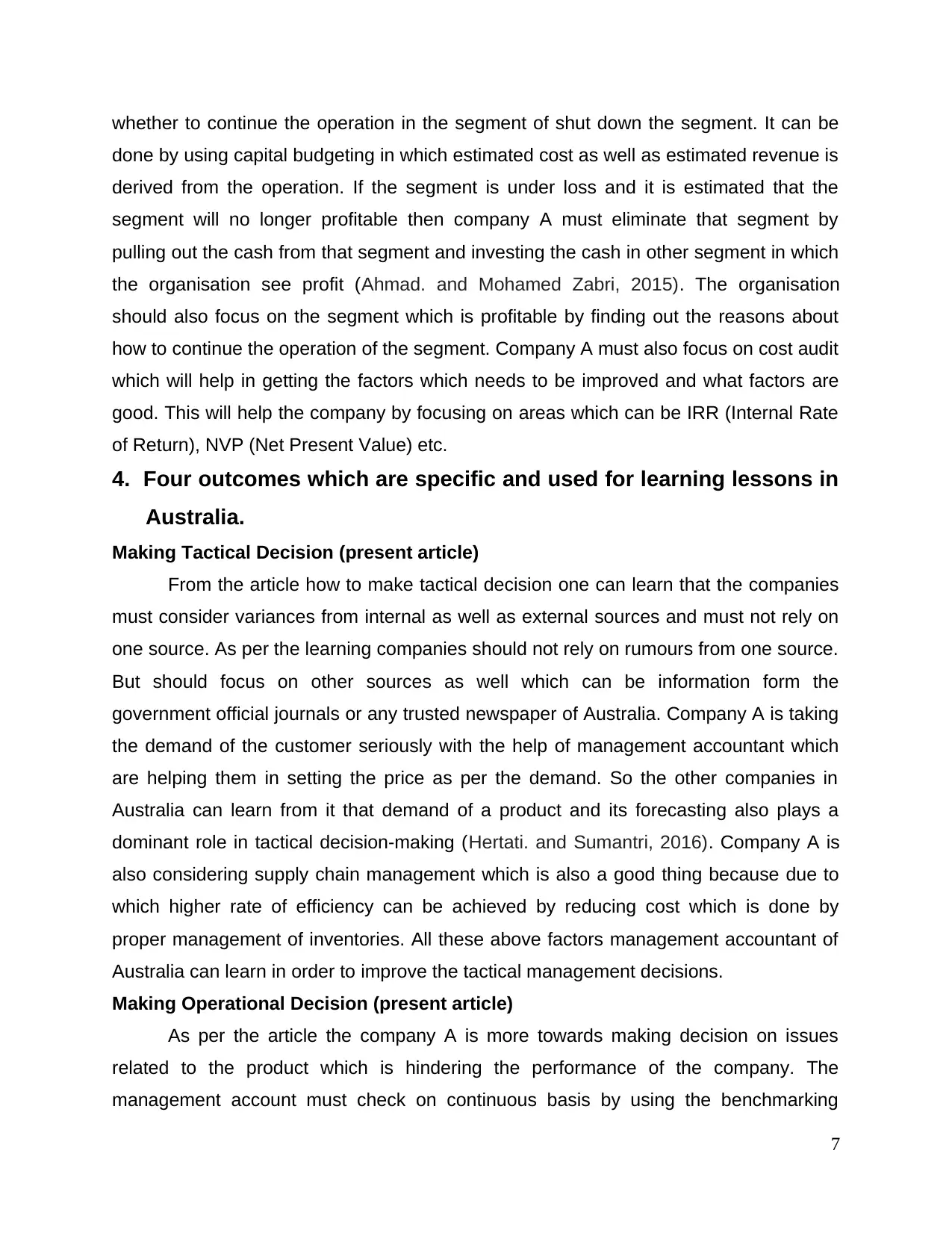
whether to continue the operation in the segment of shut down the segment. It can be
done by using capital budgeting in which estimated cost as well as estimated revenue is
derived from the operation. If the segment is under loss and it is estimated that the
segment will no longer profitable then company A must eliminate that segment by
pulling out the cash from that segment and investing the cash in other segment in which
the organisation see profit (Ahmad. and Mohamed Zabri, 2015). The organisation
should also focus on the segment which is profitable by finding out the reasons about
how to continue the operation of the segment. Company A must also focus on cost audit
which will help in getting the factors which needs to be improved and what factors are
good. This will help the company by focusing on areas which can be IRR (Internal Rate
of Return), NVP (Net Present Value) etc.
4. Four outcomes which are specific and used for learning lessons in
Australia.
Making Tactical Decision (present article)
From the article how to make tactical decision one can learn that the companies
must consider variances from internal as well as external sources and must not rely on
one source. As per the learning companies should not rely on rumours from one source.
But should focus on other sources as well which can be information form the
government official journals or any trusted newspaper of Australia. Company A is taking
the demand of the customer seriously with the help of management accountant which
are helping them in setting the price as per the demand. So the other companies in
Australia can learn from it that demand of a product and its forecasting also plays a
dominant role in tactical decision-making (Hertati. and Sumantri, 2016). Company A is
also considering supply chain management which is also a good thing because due to
which higher rate of efficiency can be achieved by reducing cost which is done by
proper management of inventories. All these above factors management accountant of
Australia can learn in order to improve the tactical management decisions.
Making Operational Decision (present article)
As per the article the company A is more towards making decision on issues
related to the product which is hindering the performance of the company. The
management account must check on continuous basis by using the benchmarking
7
done by using capital budgeting in which estimated cost as well as estimated revenue is
derived from the operation. If the segment is under loss and it is estimated that the
segment will no longer profitable then company A must eliminate that segment by
pulling out the cash from that segment and investing the cash in other segment in which
the organisation see profit (Ahmad. and Mohamed Zabri, 2015). The organisation
should also focus on the segment which is profitable by finding out the reasons about
how to continue the operation of the segment. Company A must also focus on cost audit
which will help in getting the factors which needs to be improved and what factors are
good. This will help the company by focusing on areas which can be IRR (Internal Rate
of Return), NVP (Net Present Value) etc.
4. Four outcomes which are specific and used for learning lessons in
Australia.
Making Tactical Decision (present article)
From the article how to make tactical decision one can learn that the companies
must consider variances from internal as well as external sources and must not rely on
one source. As per the learning companies should not rely on rumours from one source.
But should focus on other sources as well which can be information form the
government official journals or any trusted newspaper of Australia. Company A is taking
the demand of the customer seriously with the help of management accountant which
are helping them in setting the price as per the demand. So the other companies in
Australia can learn from it that demand of a product and its forecasting also plays a
dominant role in tactical decision-making (Hertati. and Sumantri, 2016). Company A is
also considering supply chain management which is also a good thing because due to
which higher rate of efficiency can be achieved by reducing cost which is done by
proper management of inventories. All these above factors management accountant of
Australia can learn in order to improve the tactical management decisions.
Making Operational Decision (present article)
As per the article the company A is more towards making decision on issues
related to the product which is hindering the performance of the company. The
management account must check on continuous basis by using the benchmarking
7
⊘ This is a preview!⊘
Do you want full access?
Subscribe today to unlock all pages.

Trusted by 1+ million students worldwide
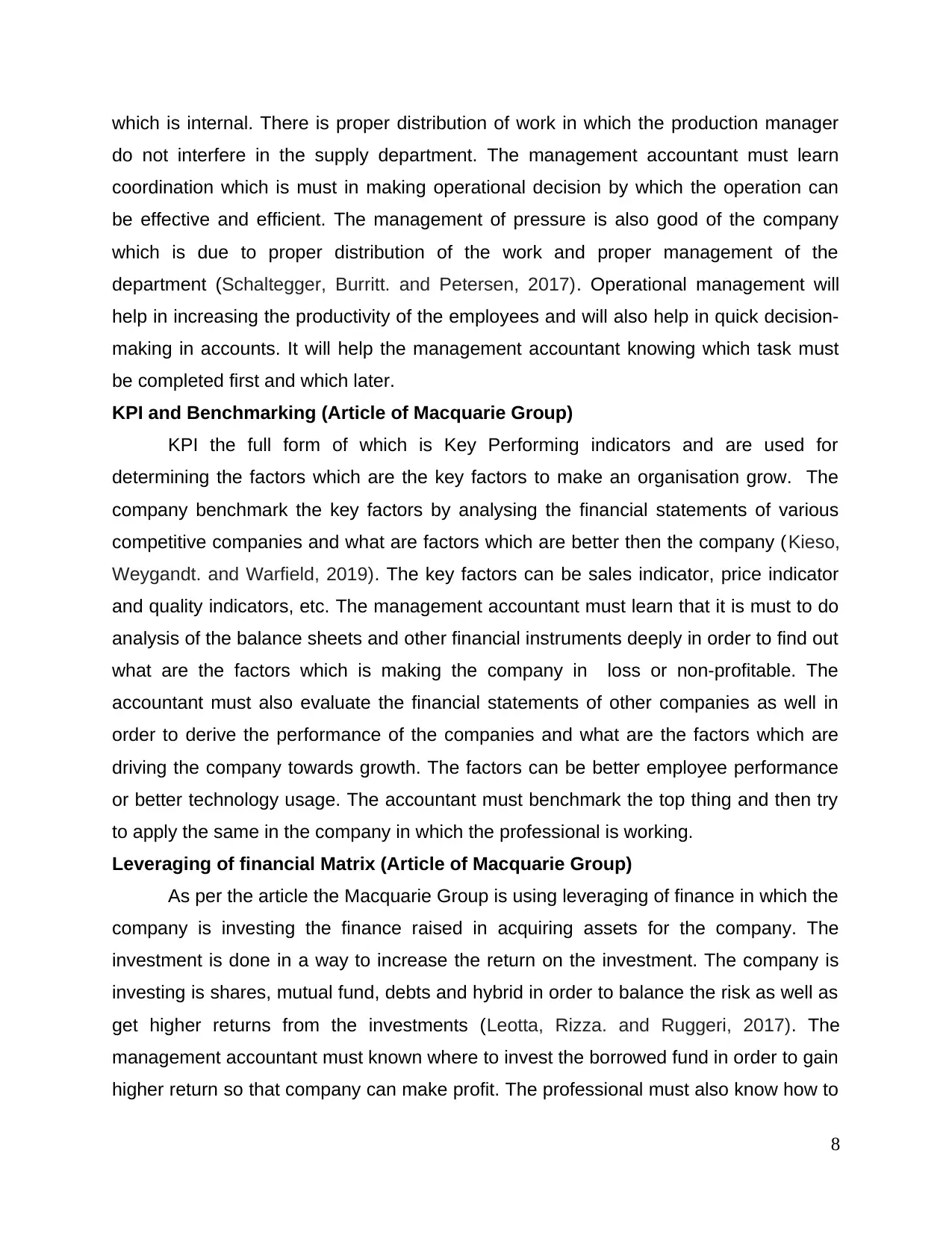
which is internal. There is proper distribution of work in which the production manager
do not interfere in the supply department. The management accountant must learn
coordination which is must in making operational decision by which the operation can
be effective and efficient. The management of pressure is also good of the company
which is due to proper distribution of the work and proper management of the
department (Schaltegger, Burritt. and Petersen, 2017). Operational management will
help in increasing the productivity of the employees and will also help in quick decision-
making in accounts. It will help the management accountant knowing which task must
be completed first and which later.
KPI and Benchmarking (Article of Macquarie Group)
KPI the full form of which is Key Performing indicators and are used for
determining the factors which are the key factors to make an organisation grow. The
company benchmark the key factors by analysing the financial statements of various
competitive companies and what are factors which are better then the company (Kieso,
Weygandt. and Warfield, 2019). The key factors can be sales indicator, price indicator
and quality indicators, etc. The management accountant must learn that it is must to do
analysis of the balance sheets and other financial instruments deeply in order to find out
what are the factors which is making the company in loss or non-profitable. The
accountant must also evaluate the financial statements of other companies as well in
order to derive the performance of the companies and what are the factors which are
driving the company towards growth. The factors can be better employee performance
or better technology usage. The accountant must benchmark the top thing and then try
to apply the same in the company in which the professional is working.
Leveraging of financial Matrix (Article of Macquarie Group)
As per the article the Macquarie Group is using leveraging of finance in which the
company is investing the finance raised in acquiring assets for the company. The
investment is done in a way to increase the return on the investment. The company is
investing is shares, mutual fund, debts and hybrid in order to balance the risk as well as
get higher returns from the investments (Leotta, Rizza. and Ruggeri, 2017). The
management accountant must known where to invest the borrowed fund in order to gain
higher return so that company can make profit. The professional must also know how to
8
do not interfere in the supply department. The management accountant must learn
coordination which is must in making operational decision by which the operation can
be effective and efficient. The management of pressure is also good of the company
which is due to proper distribution of the work and proper management of the
department (Schaltegger, Burritt. and Petersen, 2017). Operational management will
help in increasing the productivity of the employees and will also help in quick decision-
making in accounts. It will help the management accountant knowing which task must
be completed first and which later.
KPI and Benchmarking (Article of Macquarie Group)
KPI the full form of which is Key Performing indicators and are used for
determining the factors which are the key factors to make an organisation grow. The
company benchmark the key factors by analysing the financial statements of various
competitive companies and what are factors which are better then the company (Kieso,
Weygandt. and Warfield, 2019). The key factors can be sales indicator, price indicator
and quality indicators, etc. The management accountant must learn that it is must to do
analysis of the balance sheets and other financial instruments deeply in order to find out
what are the factors which is making the company in loss or non-profitable. The
accountant must also evaluate the financial statements of other companies as well in
order to derive the performance of the companies and what are the factors which are
driving the company towards growth. The factors can be better employee performance
or better technology usage. The accountant must benchmark the top thing and then try
to apply the same in the company in which the professional is working.
Leveraging of financial Matrix (Article of Macquarie Group)
As per the article the Macquarie Group is using leveraging of finance in which the
company is investing the finance raised in acquiring assets for the company. The
investment is done in a way to increase the return on the investment. The company is
investing is shares, mutual fund, debts and hybrid in order to balance the risk as well as
get higher returns from the investments (Leotta, Rizza. and Ruggeri, 2017). The
management accountant must known where to invest the borrowed fund in order to gain
higher return so that company can make profit. The professional must also know how to
8
Paraphrase This Document
Need a fresh take? Get an instant paraphrase of this document with our AI Paraphraser
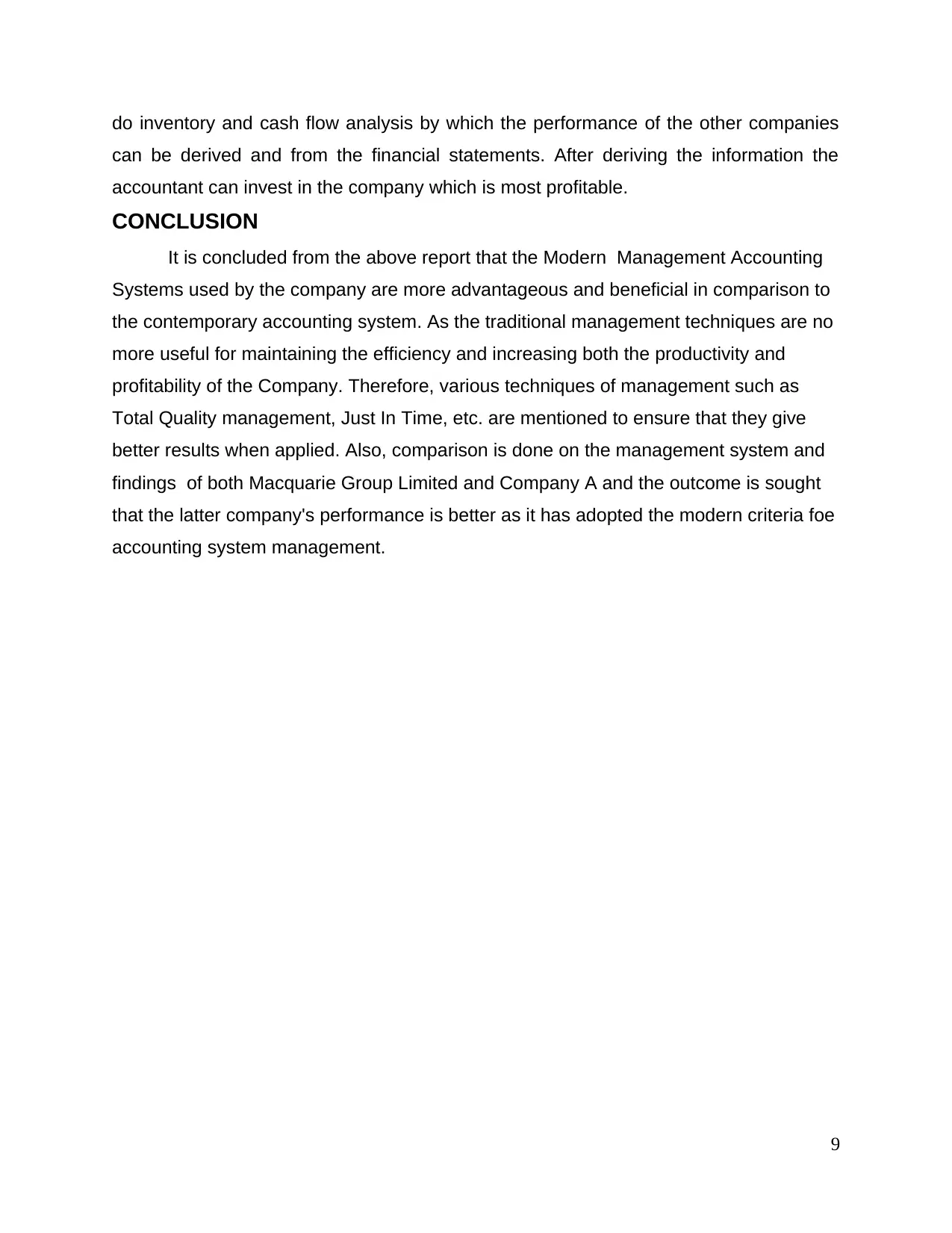
do inventory and cash flow analysis by which the performance of the other companies
can be derived and from the financial statements. After deriving the information the
accountant can invest in the company which is most profitable.
CONCLUSION
It is concluded from the above report that the Modern Management Accounting
Systems used by the company are more advantageous and beneficial in comparison to
the contemporary accounting system. As the traditional management techniques are no
more useful for maintaining the efficiency and increasing both the productivity and
profitability of the Company. Therefore, various techniques of management such as
Total Quality management, Just In Time, etc. are mentioned to ensure that they give
better results when applied. Also, comparison is done on the management system and
findings of both Macquarie Group Limited and Company A and the outcome is sought
that the latter company's performance is better as it has adopted the modern criteria foe
accounting system management.
9
can be derived and from the financial statements. After deriving the information the
accountant can invest in the company which is most profitable.
CONCLUSION
It is concluded from the above report that the Modern Management Accounting
Systems used by the company are more advantageous and beneficial in comparison to
the contemporary accounting system. As the traditional management techniques are no
more useful for maintaining the efficiency and increasing both the productivity and
profitability of the Company. Therefore, various techniques of management such as
Total Quality management, Just In Time, etc. are mentioned to ensure that they give
better results when applied. Also, comparison is done on the management system and
findings of both Macquarie Group Limited and Company A and the outcome is sought
that the latter company's performance is better as it has adopted the modern criteria foe
accounting system management.
9
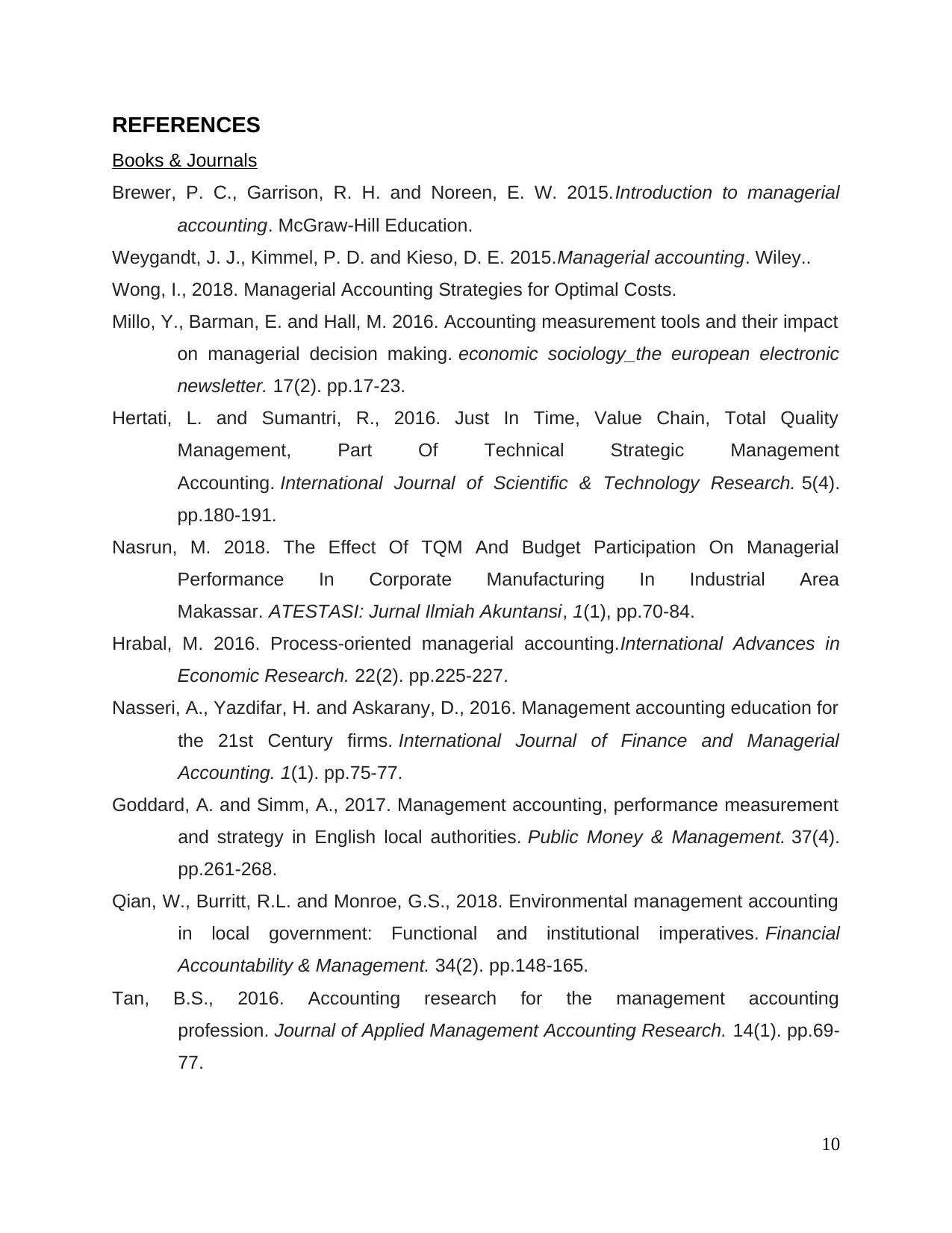
REFERENCES
Books & Journals
Brewer, P. C., Garrison, R. H. and Noreen, E. W. 2015.Introduction to managerial
accounting. McGraw-Hill Education.
Weygandt, J. J., Kimmel, P. D. and Kieso, D. E. 2015.Managerial accounting. Wiley..
Wong, I., 2018. Managerial Accounting Strategies for Optimal Costs.
Millo, Y., Barman, E. and Hall, M. 2016. Accounting measurement tools and their impact
on managerial decision making. economic sociology_the european electronic
newsletter. 17(2). pp.17-23.
Hertati, L. and Sumantri, R., 2016. Just In Time, Value Chain, Total Quality
Management, Part Of Technical Strategic Management
Accounting. International Journal of Scientific & Technology Research. 5(4).
pp.180-191.
Nasrun, M. 2018. The Effect Of TQM And Budget Participation On Managerial
Performance In Corporate Manufacturing In Industrial Area
Makassar. ATESTASI: Jurnal Ilmiah Akuntansi, 1(1), pp.70-84.
Hrabal, M. 2016. Process-oriented managerial accounting.International Advances in
Economic Research. 22(2). pp.225-227.
Nasseri, A., Yazdifar, H. and Askarany, D., 2016. Management accounting education for
the 21st Century firms. International Journal of Finance and Managerial
Accounting. 1(1). pp.75-77.
Goddard, A. and Simm, A., 2017. Management accounting, performance measurement
and strategy in English local authorities. Public Money & Management. 37(4).
pp.261-268.
Qian, W., Burritt, R.L. and Monroe, G.S., 2018. Environmental management accounting
in local government: Functional and institutional imperatives. Financial
Accountability & Management. 34(2). pp.148-165.
Tan, B.S., 2016. Accounting research for the management accounting
profession. Journal of Applied Management Accounting Research. 14(1). pp.69-
77.
10
Books & Journals
Brewer, P. C., Garrison, R. H. and Noreen, E. W. 2015.Introduction to managerial
accounting. McGraw-Hill Education.
Weygandt, J. J., Kimmel, P. D. and Kieso, D. E. 2015.Managerial accounting. Wiley..
Wong, I., 2018. Managerial Accounting Strategies for Optimal Costs.
Millo, Y., Barman, E. and Hall, M. 2016. Accounting measurement tools and their impact
on managerial decision making. economic sociology_the european electronic
newsletter. 17(2). pp.17-23.
Hertati, L. and Sumantri, R., 2016. Just In Time, Value Chain, Total Quality
Management, Part Of Technical Strategic Management
Accounting. International Journal of Scientific & Technology Research. 5(4).
pp.180-191.
Nasrun, M. 2018. The Effect Of TQM And Budget Participation On Managerial
Performance In Corporate Manufacturing In Industrial Area
Makassar. ATESTASI: Jurnal Ilmiah Akuntansi, 1(1), pp.70-84.
Hrabal, M. 2016. Process-oriented managerial accounting.International Advances in
Economic Research. 22(2). pp.225-227.
Nasseri, A., Yazdifar, H. and Askarany, D., 2016. Management accounting education for
the 21st Century firms. International Journal of Finance and Managerial
Accounting. 1(1). pp.75-77.
Goddard, A. and Simm, A., 2017. Management accounting, performance measurement
and strategy in English local authorities. Public Money & Management. 37(4).
pp.261-268.
Qian, W., Burritt, R.L. and Monroe, G.S., 2018. Environmental management accounting
in local government: Functional and institutional imperatives. Financial
Accountability & Management. 34(2). pp.148-165.
Tan, B.S., 2016. Accounting research for the management accounting
profession. Journal of Applied Management Accounting Research. 14(1). pp.69-
77.
10
⊘ This is a preview!⊘
Do you want full access?
Subscribe today to unlock all pages.

Trusted by 1+ million students worldwide
1 out of 13
Related Documents
Your All-in-One AI-Powered Toolkit for Academic Success.
+13062052269
info@desklib.com
Available 24*7 on WhatsApp / Email
![[object Object]](/_next/static/media/star-bottom.7253800d.svg)
Unlock your academic potential
Copyright © 2020–2025 A2Z Services. All Rights Reserved. Developed and managed by ZUCOL.




